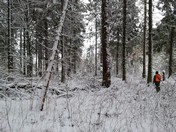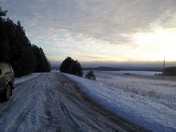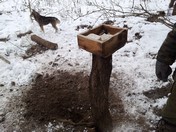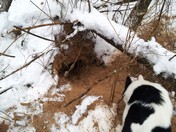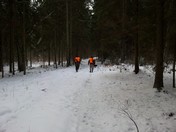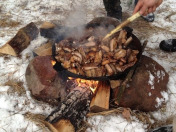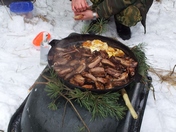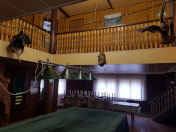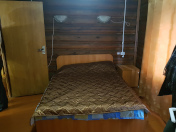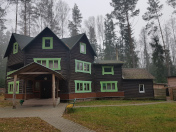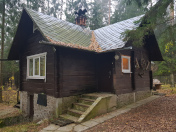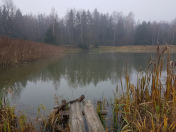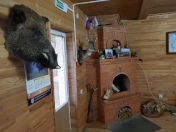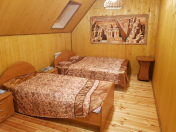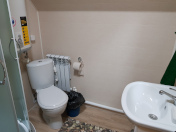Roe deer hunting in Belarus
Roe deer is a graceful animal. In the territory of the Republic of Belarus, roe deer are spread ubiquitously, but unevenly. The highest density (average by district) of this species is observed in the Gomel and Grodno regions (7.53; 6.13 individuals / 1000 hectares of forest land), then, in descending order, follow Mogilev (5.33), Vitebsk (5.09), Brest (4.40) and Minsk (3.58) regions. The Belarusian roe deer is considered to be medium-sized, but it is larger than the roe deer of other European subspecies. The body is slim and graceful. The legs are thin. The tail is short and hidden under the fur. The ears are long. The horns are found only in adult males, thin, rounded in cross section. Rather tough warm fur with a reddish color. The young roe has spots. After the first moult, the specks disappear completely.
In the summer, roe deer stay alone, only females and yearlings form groups. In the autumn-winter period, animals unite in herds of 4–8 individuals, rarely into larger ones, which exist until spring of the next year. The leader is a male. It protects pregnant females and searches for the best living conditions for the herd.
For hunters, the meat and skin of roe deer are of the greatest interest. The taste of roe deer meat does not change during the rut, it is considered a delicacy.
Hunting roe deer in our country is allowed during a certain period, from May till December, under special licenses. Trophy roe will cost the hunter almost a hundred dollars. In Belarus, the following hunting types are permitted for these animals: driven, with a decoy, ambush hunting, stalk hunting.
Stalk Hunting
Roe deer are very sensitive animals and react to the slightest rustle, thus it is very easy to scare them away. But if the hunter goes upwind, the roe will not be able to quickly identify the human approaching.
This type of hunting is carried out exclusively at dawn. Hunting will be particularly successful after bad weather, in the early, quiet morning. On a snowy day in the winter, you need to track down the roe deer extremely carefully. The encounter can literally last seconds. The first step, the second one, stop and inspect the area. You mustn’t make quick movements, you need to be sneaking, trying to blend with the surrounding nature. After the shot, the animal isn’t always able to determine where the sound is coming from and often starts to run towards the hunter. Only after the next several shots, they begin to navigate and run in the other direction.
Driven Hunting
Hunters should be divided into two groups: shooters and beaters. Hunting will be successful, thanks to good knowledge of the area and the habits of roe deer.
Driven roe hunting is carried out in the same way as for other ungulates.
Due to the fact that the roe deer has rather weak eyesight, there is no need for the hunter to hide carefully.
If you stand still, the roe will not notice the human and will calmly come to the distance of a gunshot. The beaters should make a lot of noise, as the roe deer flee from fear, not paying attention to the shooters, who are standing ahead. However, you should not make too much noise. Roe deer may find a way out of the pen. The free wings have to be blocked the poles with flags. Even a small breeze will make the flags tremble, which will not allow the roe deer to head that way.
If the roe is only injured, it cannot be released from the pen. If the shot animal flees anyway, specially trained dogs will help to catch up with it.
Hunting roe deer with a decoy
Carried out during the roe deer rut.
This type of hunting is similar to the hunting of moose with decoys.
The hunter imitates the call-up sounds, luring a male only or a male along with a female.
Hunting with a decoy should be carried out at a later period, because the number of rutting females is sharply reduced and males are more willing to run to this sound.
Online tour application
Cost for hunting and services in EUR, European roe
| Horns with the skull without the lower jaw, weight (grams) | |
| Up to 199 | 100 |
| From 200 to 249 | 125 |
| From 250 to 299 | 160 |
| From 300 to 349 | 250 for 300 g + 1,7 EUR for every gram |
| From 350 to 499 | 335 for 350 g + 2,5 EUR for every gram |
| From 500 and more | 710 for 500 g + 3,5 EUR for every gram |
| Shooting a grown-up non-trophy male | 100 |
| Shooting a female | 100 |
| Shooting an (under) yearling | 50 |
| Wounding a male | 100 |
| Wounding a female | 100 |
| Wounding an (under) yearling | 35 |


